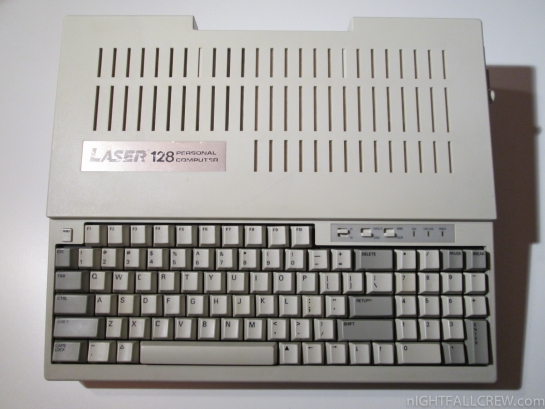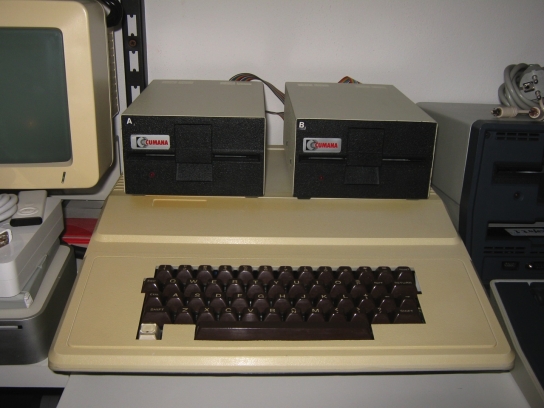Apple IIe STK Asic Clone (Maybe Orange) repair.
Defect:
- Short-circuit on all voltages.
- Black/Garbage screen.
Replaced parts:
- 10 x Tantalum Capacitor 4.7uf (replaced with Electrolytic Capacitors)
- 3 x RAM OKI M3764A-15 in Short-circuit.
- 1 x ROM 1 (EPROM 27128)
Note:
I have to thank immensely my friend Alessandro Polito for providing me the dump of the ROM 1 of the Orange (Apple IIe Asic Clone)
Download:

Autopsy:
from Wikipedia homepage:
The Laser 128 was a clone of the Apple II series of personal computers, first released by VTech in 1984. Unlike the Apple II clones from Franklin, VTech reverse-engineered the Apple ROMs using a clean room design rather than copying them. Apple Computer challenged VTech in court, but unlike its efforts directed at Franklin, Apple was unable to force the Laser 128 off the market.
As its name suggests, the Laser 128 had 128 KB of RAM. Like the Apple IIc, it was a one-piece semi-portable design with a carrying handle and a single built-in 5¼-inch floppy disk drive. Unlike the Apple IIc, it had a numeric keypad and a single Apple IIe-compatible expansion slot, which gave it better expansion capabilities than a IIc. VTech offered a metal 2-slot card cage that sat alongside the Laser 128 and attached to the computer’s single slot, allowing for even greater expansion flexibility. The Laser 128 retailed for about $700, substantially less than the price of an Apple IIc.
Apple countered the Laser 128 with its upgraded Apple IIc Plus. VTech responded with the Laser 128EX and the Laser EX2. The Laser 128 was aggressively marketed, both by mail order firms and in retail and catalog stores such as Sears. Even though its ROM was not derived from Apple’s ROM, the Laser 128 series had a high degree of compatibility with its competition from Apple.
VTech owed much of this compatibility to the fact that they were able to license Applesoft BASIC (which constitutes the largest and most complex part of an Apple II’s ROM contents) from Microsoft just as Apple did, heavily reducing the amount of code that had to be reimplemented. Microsoft had made most of its money by keeping the rights to the software that it sold to others. Likewise, Apple had failed to secure an exclusive distribution license for the Applesoft dialect of BASIC, and VTech was free to buy it. Much Apple software depended on various assembly routines that are a part of BASIC in ROM, and it’s quite likely that the Laser would not have been as successful had it not had compatible ROM entry points.
Download:
Game loading:
source: wikipedia

Autopsy:
This is a Apple II clone made by Computertechnik (SK-747 IBS Space 84) around late 70′s. This Apple computer resembles in all respects the original one.
from Wikipedia:
The Apple II is an 8-bit home computer, one of the first highly successful mass-produced microcomputer products, designed primarily by Steve Wozniak, manufactured by Apple Computer (now Apple Inc.) and introduced in 1977. It is the first model in a series of computers which were produced until Apple IIe production ceased in November 1993.
 The first Apple II computers went on sale on June 5, 1977 with a MOS Technology 6502 microprocessor running at 1 MHz, 4 kB of RAM, an audio cassette interface for loading programs and storing data, and the Integer BASIC programming language built into the ROMs. The video controller displayed 24 lines by 40 columns of monochrome, upper-case-only (the original character set matches ASCII characters 0×20 to 0x5F) text on the screen, with NTSC composite video output suitable for display on a TV monitor, or on a regular TV set by way of a separate RF modulator.
The first Apple II computers went on sale on June 5, 1977 with a MOS Technology 6502 microprocessor running at 1 MHz, 4 kB of RAM, an audio cassette interface for loading programs and storing data, and the Integer BASIC programming language built into the ROMs. The video controller displayed 24 lines by 40 columns of monochrome, upper-case-only (the original character set matches ASCII characters 0×20 to 0x5F) text on the screen, with NTSC composite video output suitable for display on a TV monitor, or on a regular TV set by way of a separate RF modulator.
The original retail price of the computer was 1298 USD (with 4 kB of RAM) and 2638 USD (with the maximum 48 kB of RAM). To reflect the computer’s color graphics capability, the Apple logo on the casing was represented using rainbow stripes, which remained a part of Apple’s corporate logo until early 1998. The earliest Apple II’s were assembled in Silicon Valley, and later in Texas; printed circuit boards were manufactured in Ireland and Singapore.
source: wikipedia








































 The first Apple II computers went on sale on June 5, 1977 with a MOS Technology 6502 microprocessor running at 1 MHz, 4 kB of RAM, an audio cassette interface for loading programs and storing data, and the Integer BASIC programming language built into the ROMs. The video controller displayed 24 lines by 40 columns of monochrome, upper-case-only (the original character set matches ASCII characters 0×20 to 0x5F) text on the screen, with NTSC composite video output suitable for display on a TV monitor, or on a regular TV set by way of a separate RF modulator.
The first Apple II computers went on sale on June 5, 1977 with a MOS Technology 6502 microprocessor running at 1 MHz, 4 kB of RAM, an audio cassette interface for loading programs and storing data, and the Integer BASIC programming language built into the ROMs. The video controller displayed 24 lines by 40 columns of monochrome, upper-case-only (the original character set matches ASCII characters 0×20 to 0x5F) text on the screen, with NTSC composite video output suitable for display on a TV monitor, or on a regular TV set by way of a separate RF modulator.


Recent Comments